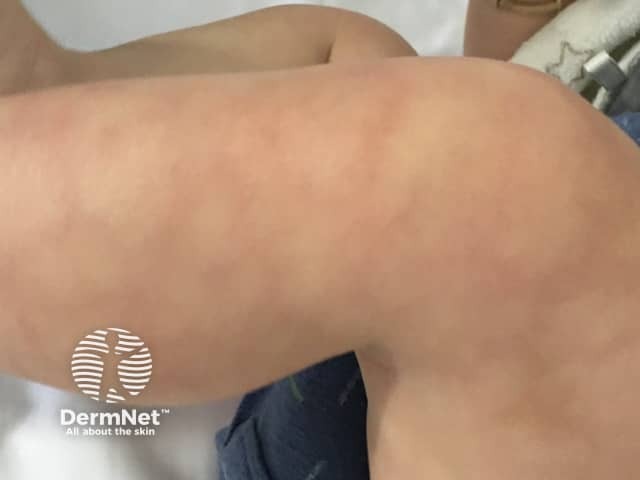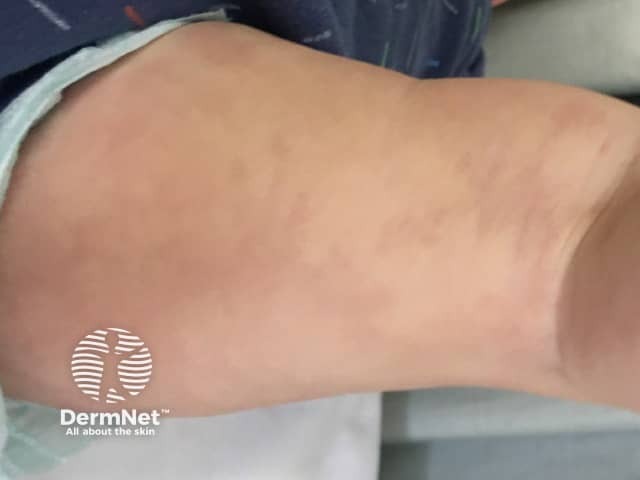Main menu
Common skin conditions

NEWS
Join DermNet PRO
Read more
Quick links
Cutis marmorata telangiectatica congenita — extra information
Cutis marmorata telangiectatica congenita
Author: Dr Emily Ryder, Dermatology Registrar, Waikato Hospital, Hamilton, New Zealand; Chief Editor: Dr Amanda Oakley, Dermatologist, Hamilton, New Zealand, 2014. Updated by Dr Lisa Connelly, Dermatologist, New Plymouth, New Zealand, July 2017.
Introduction
Demographics
Causes
Clinical features
Diagnosis
Management
Outcome
What is cutis marmorata telangiectatica congenita?
Cutis marmorata telangiectatica congenita is an uncommon congenital capillary vascular malformation. It should not be confused with cutis marmorata, a normal physiologic skin mottling in cool environments.
Who gets cutis marmorata telangiectatica congenita?
Cutis marmorata telangiectatica congenita is rare. It is usually sporadic, and family members are unaffected. However, several members of a family may occasionally have CMTC.
What causes cutis marmorata telangiectatica congenita?
The cause of cutis marmorata telangiectatica congenita is unknown but is likely to be a genetic mutation. A possible variation in the ARL6IP6 gene has been suggested.
The child may have other congenital naevi, such as a café-au-lait macule, mongolion spot (dermal melanocytosis), naevus flammeus, type 5 phakomatosis pigmentovascularis or other vascular birthmarks.
What are the clinical features of cutis marmorata telangiectatica congenita?
Cutis marmorata telangiectatica congenita is present at birth. It is characterised by fixed patches of mottled skin with a net-like or reticulate blue to pale purple patches (livedo reticularis). Unlike physiological cutis marmorata, the marks do not fade with warming.
CMTC may appear indented due to dermal atrophy (loss of dermis). Atrophy of the epidermis and rarely ulceration may also occur. It is most commonly associated with ipsilateral limb hypotrophy (smaller, shorter limb).
Shortly after birth, the red or pink patches of skin may also be confused with a port wine stain or early infantile haemangioma.
Two congenital abnormalities are associated with cutis marmorata telangiectatica congenita: Adams–Oliver syndrome and phakomatosis pigmentovascularis.
Adams-Oliver syndrome
The main features of Adams–Oliver syndrome are:
- CMTC
- Aplasia cutis congenita of the scalp
- Distal limb reduction anomalies
Phakomatosis pigmentovascularis
The main features of phakomatosis pigmentovascularis are:
- Vascular malformation
- Melanocytic naevi.
Other associations
Macrocephaly–CMTC has been renamed macrocephaly–capillary malformation (MCM) since skin lesions in MCM represent reticulated port wine stains rather than cutis marmorata.
Persistent cutis marmorata maybe be seen in patients with Down syndrome, trisomy 18 and Cornelia de Lange syndrome.
Extra-cutaneous findings of cutis marmorata telangiectatica congenita include:
- Limbs: 50% of patients will present with a limb length discrepancy and asymmetry
- Eyes: congenital retinal detachment, glaucoma, leukoconia
- CNS: developmental delay

Cutis marmorata telangiectatica congenita

Cutis marmorata telangiectatica congenita

Cutis marmorata telangiectatica congenita
How is the diagnosis of cutis marmorata telangiectatica congenita made?
Diagnosis of cutis marmorata telangiectatica congenita is usually based on the identification of the specific skin appearances by an experienced dermatologist or paediatrician.
Management of cutis marmorata telangiectatica congenita
There is no specific treatment for the skin lesions of cutis marmorata telangiectatica congenita.
Affected children with limb length discrepancies should be monitored with standing leg-length radiographs at the age of 10 (girls) or 12 (boys), or if the limb length discrepancy is greater or equal to 2 cm. Orthopaedic referral is advised for limb length discrepancies over 2 cm for epiphysiodesis (fusion of bone growth plate) and surgical consideration.
What is the outcome for cutis marmorata telangiectatica congenita?
Cutis marmorata telangiectatica congenita slowly fades over the first years of life.
References
- Ponnurangam VN1, Paramasivam V1.Cutis marmorata telangiectatica congenita. Indian Dermatol Online J. 2014 Jan;5(1):80-2. doi: 10.4103/2229-5178.126042. PubMed
- Sharma J. Cutis marmorata telangiectatica congenita. J Clin Neonatol. 2013 Oct;2(4):199. doi: 10.4103/2249-4847.123107. PubMed
- BenAmitai D, Fichman S, Merlob P, Morad Y, Lapidoth M, Metzker A. Cutis marmorata telangiectatica congenita: clinical findings in 85 patients. Pediat. Derm. 17: 100-104, 2000.
- Kniffin L. OMIM Database #219250. Johns Hopkins University. Accessed December 2014.
- Memarzadeh A, Pengas S, Eastwood D.M. Limb length discrepancy in cutis marmorata telangiectasia congenita: an audit of assessment and management in a multidisciplinary setting. Br J of Dermatol. 2013 Mar;170(3):681-6. doi 10.1111/bd.12700. PubMed.
- Rucker Wright D, Frieden I, Orlow S, Shin H, Chamlin S, Schaffer J, Paller A. The misnomer “Macrocephaly-cutis marmorata telangiectasia congénita syndrome” report of 12 new cases and support for revising the name to macrocephaly-capillary malformation. Arch Dermatol. 2009 Mar; 145(3):287-293. doi:10.1001/archdermatol.2008 545. PubMed.
On DermNet
Other websites
- Cutis Marmorata Telangiectatica Congenita — Medscape Reference
- CUTIS MARMORATA TELANGIECTATICA CONGENITA — OMIM
